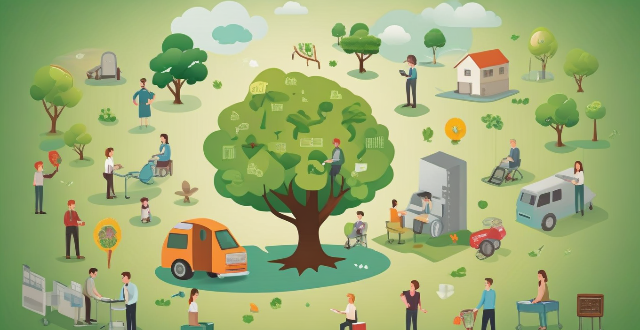Include Sustainable

How does sustainable investing work ?
Sustainable investing, also known as responsible or impact investing, involves making investment decisions based on environmental, social, and governance (ESG) criteria. The goal is to generate long-term financial returns while also considering the broader impact of investments on society and the environment. Here's how sustainable investing works: 1. Identify ESG Criteria: The first step in sustainable investing is to identify the ESG criteria that align with your values and risk tolerance. This could include factors such as carbon emissions, labor practices, diversity, board composition, and more. 2. Screen Investments: Once you have identified your ESG criteria, you can screen potential investments to ensure they meet your standards. This can be done through negative screening (excluding companies that don't meet certain criteria) or positive screening (selecting companies that exceed certain criteria). 3. Integrate ESG into Investment Process: Sustainable investing goes beyond simply screening investments; it involves integrating ESG considerations into the entire investment process. This includes researching companies' ESG performance, engaging with them to encourage improvements, and monitoring their progress over time. 4. Measure Performance: Like any investment strategy, it's important to measure the performance of your sustainable investments. This includes tracking financial returns as well as evaluating the impact of your investments on society and the environment. 5. Rebalance and Review: Finally, sustainable investing requires ongoing monitoring and rebalancing of your portfolio to ensure it continues to align with your ESG criteria and financial goals. This may involve selling off underperforming investments or reallocating funds to new opportunities that better meet your standards.

What is sustainable investing ?
Sustainable investing incorporates environmental, social, and governance factors into investment strategies. It aims for long-term financial returns while promoting positive societal change and minimizing harm to the environment. Environmental considerations include climate change and pollution prevention; social factors involve labor standards and community involvement; governance focuses on transparency and ethical behavior. Benefits of sustainable investing include risk mitigation, long-term returns, and impactful investments.

What are the benefits of using sustainable energy sources ?
Using sustainable energy sources provides environmental, economic, and social benefits. These include reduced greenhouse gas emissions, improved air quality, conservation of natural resources, protection of ecosystems, cost savings, job creation, energy independence, stable energy prices, improved public health, community resilience, education and innovation, and increased energy access. Transitioning to sustainable energy is essential for our future prosperity and survival.

How can we ensure that the benefits of sustainable development reach everyone, including the most vulnerable groups ?
The text discusses how sustainable development can be ensured to reach everyone, including the most vulnerable groups. It suggests a multifaceted approach that involves balancing economic growth, social inclusion, and environmental protection. The strategies include developing inclusive policies, ensuring access to opportunities like education and training, investing in sustainable infrastructure and accessible services, encouraging community engagement and advocacy, and implementing monitoring and accountability measures. By working together across sectors and levels of society, a more equitable and sustainable future can be built for all.

How do I choose a sustainable investment fund ?
Choosing a sustainable investment fund requires careful consideration of various factors, including your investment goals, the fund's ESG criteria and performance history, the experience of the fund manager, the fund's holdings and alignment with your values, fees and expenses, and ongoing monitoring of your investment. By following these steps, you can select a sustainable fund that aligns with your financial goals and personal values.

What challenges do we face in achieving a continuous supply of sustainable energy ?
The challenges to achieving a continuous supply of sustainable energy include technological limitations, economic barriers, political and social factors, infrastructure and grid integration issues, and environmental impacts. Addressing these challenges requires collaboration between governments, businesses, and individuals to work towards a more sustainable future for our planet.

What are the benefits of sustainable consumption ?
The text discusses the benefits of sustainable consumption, which include environmental protection, economic benefits, social well-being, and ethical considerations. By making conscious choices about what we consume and how we dispose of our waste, we can reduce our carbon footprint, conserve natural resources, preserve biodiversity, save costs, create jobs, promote healthier lifestyles, ensure equitable distribution of resources, build community, protect animal welfare, support fair trade, and encourage transparency and accountability in businesses. Sustainable consumption is crucial for creating a more sustainable future for ourselves and future generations.

What are some examples of sustainable investments ?
Sustainable investments are becoming increasingly popular as investors seek to generate financial returns while also contributing to environmental and social causes. Examples of sustainable investments include green bonds, sustaple stocks, impact investing, and sustainable real estate. These investments offer benefits such as reducing carbon emissions, promoting renewable energy sources, supporting fair labor practices, and potentially earning competitive returns over time. By choosing to invest sustainably, investors can play an active role in protecting the environment, creating a more equitable society, and achieving financial success.

How can businesses contribute to sustainable consumption ?
Businesses can contribute to sustainable consumption by adopting circular economy principles, managing green supply chains, using eco-friendly packaging, practicing product stewardship, improving energy efficiency, conserving water, engaging in responsible marketing, promoting innovation, engaging stakeholders, and supporting environmental initiatives. These practices help reduce waste, minimize resource use, and inspire sustainable consumer behavior.

Can sportswear companies produce more sustainable products ?
Sportswear companies can produce more sustainable products by using eco-friendly materials, reducing waste, and adopting circular economy principles.

What are the main sources of sustainable energy ?
The text discusses the various main sources of sustainable energy, including solar energy, wind energy, hydropower, geothermal energy, bioenergy, tidal and wave energy, and hydrogen energy. It also highlights the importance of adopting sustainable energy for environmental impact, economic benefits, energy security, and health considerations. The transition to sustainable energy requires investment, policy support, and technological innovation.

How do climate-friendly products contribute to sustainable development ?
The article discusses the importance of climate-friendly products in sustainable development. These products help reduce greenhouse gas emissions, conserve natural resources, support renewable energy sources, and encourage eco-friendly lifestyles. By using less energy or producing fewer pollutants during their production, use, and disposal, these products contribute to a healthier planet for future generations. Examples include energy-efficient appliances, electric vehicles, reusable water bottles made from recycled materials, bamboo toothbrushes, solar panels, wind turbines, hydroelectric generators, cloth shopping bags, and compostable food containers. As consumers become more aware of the environmental impact of their choices, they can make informed decisions that support a more sustainable future.

How does sustainable consumption impact the economy ?
Reduced resource depletion, lower energy costs, increased innovation, and improved public health are some of the key benefits of sustainable consumption. While there may be short-term costs associated with transitioning to more sustainable practices, the long-term benefits far outweigh these costs.

How can sustainable investing help achieve the United Nations Sustainable Development Goals ?
Sustainable investing, which incorporates environmental, social, and governance criteria into investment decision-making, can significantly contribute to achieving the United Nations Sustainable Development Goals. It promotes environmentally friendly practices, enhances social well-being, advances economic growth and innovation, upholds good governance and partnerships, drives market trends towards sustainability, and attracts conscience-driven consumers. By aligning financial objectives with positive societal impact, sustainable investing creates a framework for long-term, sustainable growth that benefits people, planet, and profit.

What are the best practices for sustainable groundwater management ?
The provided text discusses the importance of sustainable groundwater management and outlines several best practices to ensure the long-term availability and quality of this vital resource. These practices include monitoring and data collection, enhancing recharge, maintaining sustainable withdrawal rates, protecting groundwater from pollution, integrated water resources management, legal and policy framework, public participation and education, technological innovation, and responding to climate change. By following these guidelines, depletion, contamination, and environmental damage can be prevented, supporting ecosystems, agriculture, and human consumption.

How does climate adaptation relate to sustainable development goals ?
Climate adaptation is a vital component of sustainable development goals (SDGs) as it helps reduce vulnerabilities and build resilience to the adverse effects of climate change, thereby contributing to the achievement of several SDGs. Relevant SDGs include Goal 1: No Poverty, Goal 2: Zero Hunger, Goal 3: Good Health and Well-being, Goal 6: Clean Water and Sanitation, Goal 11: Sustainable Cities and Communities, Goal 13: Climate Action, and Goal 15: Life on Land. Strategies for integration include policy coherence, financial investment, capacity building, stakeholder participation, risk assessment, research and innovation, and education and awareness. By addressing the challenges posed by climate change through effective adaptation strategies, nations can work towards creating more resilient societies that are better prepared to face future climate risks while continuing to progress towards other SDGs.

How can wind energy contribute to a sustainable future ?
Wind energy is a renewable and sustainable source of power that can significantly contribute to a more sustainable future. It offers several benefits including reducing carbon emissions, stimulating economic growth, enhancing energy security, driving technological innovation, compatible land use, community engagement, scalability, improving health impacts, and promoting education and awareness. By incorporating wind energy into our energy mix, we can create a cleaner, healthier, and more sustainable environment for future generations.

What are the risks of sustainable investing ?
Sustainable investing carries risks such as inconsistent screening criteria, limited investment opportunities, higher costs, regulatory and legal issues, market risks, and reputational risks. Investors should carefully consider these risks before making investment decisions to ensure that sustainable investing aligns with their goals and risk tolerance.

What impact have celebrities had on promoting sustainable fashion ?
### Summary: Celebrities significantly influence sustainable fashion promotion by raising awareness, shaping trends, supporting eco-friendly brands, driving industry changes, and setting personal examples of sustainability. Through campaigns, social media engagements, and public appearances in sustainable fashion, they encourage followers to adopt more environmentally conscious choices. Their actions not only increase the visibility of sustainable brands but also push for greater transparency and ethical practices within the fashion industry.

How does climate resilience relate to sustainable development ?
Climate resilience and sustainable development are interconnected concepts that aim to ensure the long-term well-being of our planet and its inhabitants. They share common goals, such as addressing global challenges like poverty, inequality, and environmental degradation by integrating short-term actions with long-term visions. Climate resilience refers to the ability of a system, community, or society to withstand and recover from the impacts of climate change, including extreme weather events such as hurricanes, floods, and droughts. It involves adapting to changing environmental conditions while maintaining essential functions and services. Key elements of climate resilience include adaptation, mitigation, preparedness, and recovery. Sustainable development is development that meets the needs of the present without compromising the ability of future generations to meet their own needs. It balances economic growth, social inclusion, and environmental protection for long-term prosperity. The three pillars of sustainable development are economic, social, and environmental. The intersection of climate resilience and sustainable development lies in their complementary goals, mutual benefits, integrated approaches, and policy coherence. Achieving climate resilience can support sustainable development by reducing vulnerabilities to climate change, which in turn can help maintain economic stability and protect livelihoods. Pursuing sustainable development can enhance climate resilience by promoting clean energy sources, efficient resource use, and robust ecosystems that can absorb the impacts of climate change. Integrating climate resilience into sustainable development strategies ensures that efforts to combat climate change are not isolated but rather part of a broader plan for sustainable living. This includes investing in renewable energy, building green infrastructure, and fostering sustainable agriculture practices. Governments and organizations must ensure policy coherence between climate action and sustainable development goals. By aligning policies, they can avoid conflicting objectives and maximize synergies between these two critical areas. In conclusion, climate resilience and sustainable development are not only compatible but also mutually reinforcing. Building resilience against climate change impacts is an integral part of achieving sustainability, just as pursuing sustainable pathways can strengthen our capacity to adapt and thrive in a changing climate. Together, they offer a comprehensive approach to securing a resilient and sustainable future for all.

How can we create a sustainable economy that benefits both people and the planet ?
To create a sustainable economy that benefits both people and the planet, several strategies must be employed. These include shifting to renewable energy sources, promoting circular economy practices, encouraging green innovations and technology, implementing sustainable agriculture practices, supporting local economies and fair trade, and raising awareness and education about sustainability. By taking these steps, we can ensure the well-being of current and future generations while minimizing waste, reducing environmental impacts, and conserving natural resources.

What are some innovative ways to generate sustainable energy ?
The article discusses various innovative ways to generate sustainable energy. These methods include solar power, wind power, hydropower, geothermal energy, biomass energy, and wave energy, each with their unique techniques and systems.

What role do governments play in promoting sustainable development ?
The article discusses the various ways governments can contribute to sustainable development, including leadership and policy-making, education and awareness, infrastructure and investment, regulation and enforcement, and collaboration and partnership. Governments are responsible for setting national policies and priorities that guide the actions of their citizens and businesses, promoting sustainable development through education and public awareness campaigns, investing in infrastructure projects that support environmental protection, energy efficiency, and renewable energy sources, enforcing existing laws and regulations related to environmental protection, resource management, and social equity, and working together with other levels of government, the private sector, civil society, and international organizations to achieve common sustainability goals.

How can citizens engage with businesses to promote more sustainable practices ?
The article discusses the crucial role of citizens in promoting sustainable practices within businesses. It offers a detailed guide on how individuals can engage with companies to drive change and foster a more sustainable future. The suggested strategies include educating oneself about sustainability issues, supporting sustainable brands, engaging in dialogue with businesses, participating in campaigns initiated by NGOs or other organizations, using social media to raise awareness, providing feedback to businesses, advocating for policies that support sustainability, and starting conversations about sustainability among peers. By employing these strategies, citizens can effectively engage with businesses and promote more sustainable practices.

What is the importance of sustainable agriculture in achieving the Sustainable Development Goals ?
Sustainable agriculture is crucial for achieving the United Nations' Sustainable Development Goals by ensuring food security, improving rural livelihoods, and protecting the environment. It promotes soil health, increases crop yields, encourages biodiversity, creates jobs in rural areas, enhances income, promotes gender equality, reduces greenhouse gas emissions, conserves water resources, prevents land degradation, supports climate change mitigation and adaptation, stimulates economic growth, and reduces poverty. By adopting sustainable agriculture practices, we can create a more equitable and resilient world for future generations.

How can we promote sustainable development to reduce the risk of climate conflicts ?
Sustainable development is crucial for reducing the risk of climate conflicts. To promote it, we can increase awareness and education, promote renewable energy sources, implement sustainable agriculture practices, invest in green infrastructure, encourage waste reduction and recycling, and collaborate with governments and NGOs.

Why is sustainable investing important ?
Sustainable investing is crucial for the future of our planet and society. It considers environmental impact, social responsibility, long-term returns, risk management, and ethical considerations of companies. By investing in sustainable companies, investors can help combat climate change, create a more equitable society, and achieve long-term financial returns. Sustainable investing also aligns with many people's personal values and ethics.

How do climate change mitigation efforts interact with sustainable development goals ?
Climate change mitigation efforts and sustainable development goals (SDGs) are closely interconnected, as both aim to achieve a more sustainable future for our planet. In this article, we will explore the relationship between these two important initiatives and how they can work together to create a better world. Climate change mitigation refers to actions taken to reduce or prevent the release of greenhouse gases into the atmosphere. Some examples of climate change mitigation efforts include renewable energy, energy efficiency, forest protection, sustainable agriculture, and waste management. The United Nations has set 17 sustainable development goals (SDGs) to address global challenges such as poverty, inequality, environmental degradation, and climate change. These goals aim to promote economic growth, social inclusion, and environmental protection while ensuring that no one is left behind. Climate change mitigation efforts and SDGs interact in several ways, as they share common goals and strategies. By working together to address these challenges, we can create a more sustainable future for our planet and ensure that no one is left behind.

How do Climate-Smart Technologies contribute to sustainable development ?
Climate-smart technologies play a crucial role in sustainable development by offering solutions that mitigate climate change, adapt to its impacts, and ensure food security while promoting economic growth. These technologies are resource-efficient, low-carbon, and resilient, making them integral components of the sustainable development goals (SDGs). Key ways in which climate-smart technologies contribute to sustainable development include: - Mitigating climate change through renewable energy sources like solar power, wind energy, and hydroelectric power; energy efficiency measures such as building insulation, LED lighting, and smart grids; adapting to climate impacts with water management systems like rainwater harvesting, drought-resistant crops, and flood control infrastructure; agricultural innovations such as precision farming, agroforestry, and cover cropping; enhancing economic growth with green industries like eco-tourism, clean manufacturing, and carbon trading markets; creating jobs and alleviating poverty through sustainable agriculture, renewable energy sector, and climate finance; promoting social well-being through health and safety measures like air quality monitoring, disaster early warning systems, and access to clean cooking solutions; and education and awareness initiatives including climate education programs, community-based adaptation projects, and research and development.

Is it possible to create a truly sustainable "green" battery ?
Creating a truly sustainable "green" battery is an ambitious goal that aligns with the global effort to reduce environmental impact and transition towards renewable energy sources. However, achieving this objective presents significant challenges and requires innovations in materials, design, and production processes. Key considerations for sustainable batteries include eco-friendly raw materials sourcing, recyclability, energy-efficient manufacturing processes, waste management, high energy density, longevity, comprehensive recycling programs, and secondary uses. Challenges and trade-offs involve technological limitations such as research and development needs and potential performance trade-offs, economic implications like increased production costs and market adoption challenges, as well as legislative and regulatory frameworks needed to promote green batteries. In conclusion, creating a truly sustainable "green" battery is feasible but complex, involving multifaceted approaches across material selection, manufacturing processes, product performance, and end-of-life management.